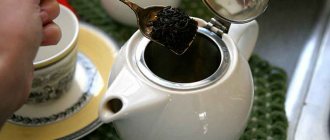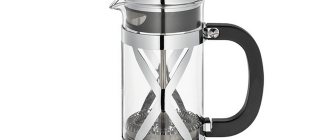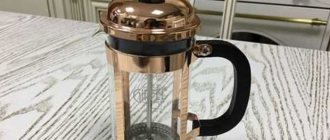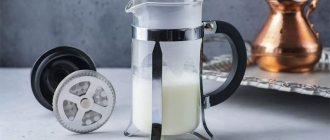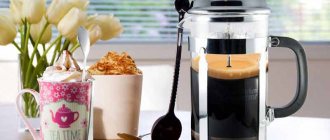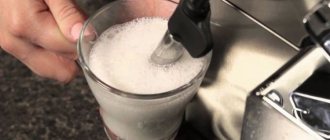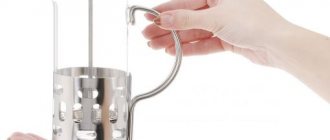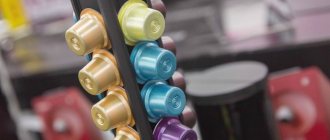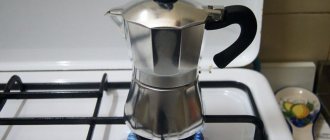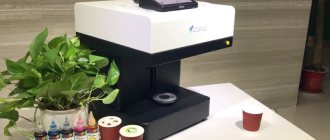There is a teapot in every kitchen. And even if preference is given to tea bags, the most ordinary teapot must be stored somewhere on the back shelf of the closet. At the same time, in our country, ordinary porcelain “pot-bellied” models are more often used, and French presses, which are much more convenient, for some reason are seriously inferior to them in popularity.
Perhaps the whole point is that they appeared in stores relatively recently, so many simply do not suspect why French presses are better than ordinary kettles. So why not talk about their convenience?
How does a French press work: how it works
The French press looks like a teapot. But it differs from it in its more elongated straight shape, small spout and press, which is the main feature of the French teapot with a press.
Let's figure out how the French press works. It consists of the following parts:
- Flask;
- Handle that connects the bottom and upper housing fasteners;
- Plunger – a piston with a press;
- Filter in the form of a fine mesh;
- The cover in which the plunger is mounted.
How does a French press work?
How does a French press work?
It’s simple: pour the brewing mixture into a flask, add water, cover with a lid and let it brew for a few minutes according to the recipe. When the infusion is ready, the plunger is smoothly lowered down. This way, all the grounds remain under pressure, and at the top you get a clean drink that can be poured into cups. You cannot place such coffee pots on heat sources or heat them!
By the way, the French press is used not only for making coffee and tea, but also for the most unexpected processes. The editors of a well-known gastronomic publication proved through experiments that a piston teapot can be used, for example, for:
- Preparing foamy milk for latte or cappuccino (the milk for frothing should be at a temperature of 60°C);
- Soaking and washing cereals or dried fruits;
- Preparation of almond milk.
A little about the past
Teapots have an ancient history. They appeared in China. The great tea culture was born there.
It was in China that they began to make dishes from clay. According to legend, the first author of this method was a Chinese official, Fan Li, from Qiangzu province in the city of Yixing. He opened the first workshops back in 400 BC. e., where they worked with ceramics, for which he received the title “Prince of Red Clay.”
A little later, the Chinese were the first to understand which teapot is better to brew tea in - a cast iron one. This material differed favorably from the others in that it heated well and retained heat for quite a long time. Then porcelain was invented, and he became the leader in the production of teapots. In terms of its properties, it can still be compared with ancient clay.
Choosing a French Press
Wondering which French press to choose?
, you need to decide what kind of drink you want to prepare in it. For example, for large-leaf tea, a model with a metal filter sieve is best suited, for fine coffee - with a synthetic fine strainer. But this is not a strict rule; no one forbids you to brew coffee and tea alternately in a French press (although you will have to carefully clean the filter from the remnants of the previous brew).
By the way, French coffee brewers have a special lid design. It goes deep enough into the flask, which allows you to achieve a greenhouse effect and better brewing of coffee.
But what’s really important is the volume of the teapot! For one person, a volume of 350 ml is sufficient; for a family of 4 people, a liter flask is optimal.
Bulb material
The most common option is containers made of heat-resistant glass. In order not to be left without a coffee pot if the glass flask suddenly breaks, choose offers with a spare flask included. Or a model for which you can easily select a replacement tank. Choose flasks with the most common sizes.
Double-walled glass flasks retain heat even better and help the coffee or tea extract better. But if you break such a flask, then finding a replacement will be very problematic - you will have to buy a new French press.
There are also exotic and expensive French presses with ceramic or stainless steel flasks. The latter, of course, are stronger and more durable than glass ones, but the brewing process will not be visible. And it is this little detail that gives piston coffee pots a special charm. Many coffee lovers believe that the richest taste of coffee is obtained in ceramic French presses.
Before purchasing, feel the flask and inspect it thoroughly: there should be no chips or dents on it. It should also fit easily and without undue effort into the cup holder of the French press, because, as you know, when heated, the material expands, and the flask must have a small margin for thermal expansion, otherwise it will burst.
Housing material
We are often asked “which French press is better: plastic or metal?” Each material has its own advantages and disadvantages. The first option is cheaper, the plastic handle does not heat up and does not rust, but the body and handle mount are often quite fragile. We recommend choosing a teapot with a solid handle and a thick body. A metal French press is more durable, but the metal heats up quickly, including the handle, which is why it is not comfortable for everyone to use. Therefore, you can increasingly find coffee pots, for example, with a metal body and a polymer handle.
And metal cases rust! But this problem is relevant for cheap models that use the simplest chrome steel.
Plunger
Be sure to check whether the piston with filter moves well in the flask. There should be no gaps between the walls and the press, the piston should move without hesitation or distortion.
What kind of teapots exist these days?
Nowadays you can see many types of teapots in stores. They may differ:
- Volume. You can buy several different ones, and there will always be enough of them for family celebrations, or you can buy a small one - for two people.
- Shape. Round teapots hold heat well and distribute it well, but square teapots are also quite popular now.
- By design. Here everything depends on the imagination and ingenuity of the manufacturer.
- Method of preparing tea.
- Material of manufacture.
A traditionally shaped teapot seems a little “potbellied”, with a spout, lid and handle. But modern designs may differ, but still not lose functionality.
I would like to dwell in more detail on the materials from which teapots are made:
- Ceramic. They make the atmosphere more comfortable and keep warm for a long time, which is especially important in the winter season. Their walls are much thicker than others, and their appearance attracts attention.
- Metal. They are made from stainless steel. These dishes are durable and have an unusual style.
- Porcelain. Ideal for aesthetic lovers. The teapot looks fragile and elegant, and is also small in size.
- Clay. Having such a product, you seem to be transported to a distant and ancient era... And they remain hot for a long time.
- Glass. The most modern option. They look amazing if you place leaves, flowers and berries inside.
But which kettle is better to brew tea in? We tell you below.
How to use a French press to brew coffee
Coffee prepared in a French press has its own specifics. Despite the skepticism of some coffee lovers, experts confirm: this is real coffee, which reveals itself no worse than in coffee makers. Moreover, for example, a French press is best suited for high-altitude Arabica beans. The drink in it is tasty, even slightly sweet, without bitterness or sourness. Even if you like bitter coffee, it is not recommended to use more than 10% robusta in a blend for a piston coffee pot.
Now let's talk step by step and in detail how to brew coffee in a French press:
- Take uniformly coarsely ground coffee powder with a fraction of about 1 mm - this is twice as coarse as for a geyser coffee maker (you can use a blend, but best of all - 100% medium roast Arabica);
- Boil water and cool to a temperature of 85-92°C;
- Rinse the French press flask with hot water;
- Pour ground coffee into it (ideally freshly ground) at the rate of 7-10 g (2 level and heaped teaspoons, respectively) of powder per 100 ml of water;
- Pour in a little warm water to slightly cover the coffee and stir the mixture;
- Add hot water to the flask. Do not top up above the top of the coffee pot handle;
- Stir and cover;
- Coffee is brewed in a French press for 4-7 minutes. You will get a drink of moderate strength in just 5 minutes, and in 7 minutes you will get a more intense drink. There is no need to brew longer;
- Lower the plunger down, pour the coffee into cups and add sugar to taste.
And to give the drink an original taste, you can add spices, citrus zest or other favorite additives to the coffee powder in the flask at the time of brewing.
About filters
When purchasing a teapot with a filter, you need to be extremely careful. Always consider the fraction size. If you prefer large leaves, then it is not recommended to buy a fine mesh, but it will be useful when brewing fine, crumbly tea.
If you take this into account, the drink will turn out extremely tasty. And if not, then you may encounter weak pressure from the spout due to a clogged filter or small crumbs of crushed leaves.
How to brew tea in a French press
You and I already know: a piston brewer can be used not only for coffee. Most often it is chosen by tea lovers. Let's talk about how to use a French press to brew tea.
- Warm the teapot flask with hot water;
- Pour tea leaves into it: 2 tsp. large leaf or 1 tsp. small-leaf tea per 200 ml of hot boiled water (up to 92°C);
- Cover with a lid without lowering the press and brew for 2-3 minutes;
- After the time has passed, gently lower the plunger, separating the tea leaf from the liquid, and pour into cups.
This is a classic recipe for brewing black tea. If you like green tea, you need to drain the first infusion: a second brew is recommended - then the taste of the tea will be brighter and deeper.
The French press is especially popular among lovers of flavored teas and herbal infusions. The latter are brewed with boiled water at a temperature not exceeding 85˚C. How long to brew herbal tea in a French press depends on the type of collection: 4-10 minutes, some herbs need 15 minutes. Balance is important in this matter, because prolonged brewing of herbs can lead to the loss of their healing properties. By the way, re-brewing herbal tea is possible, but only if no more than 2 hours have passed since the first brew.
French press is an opportunity to experiment and find new tastes for tea drinks, for example, for unusual mixes of tea, herbs and fruits. Try this recipe:
- Brew black tea in advance according to the classic recipe in another brewing container;
- Warm the French press flask with hot water, of course;
- Throw 100 grams of fresh berries (blueberries, blackberries, raspberries, strawberries or other favorites) into the flask;
- Send a sprig of mint there;
- Pour in warm brewed tea, cover with a lid and let stand for 3 minutes;
- Lower the piston and you can pour the aromatic and healthy drink into cups.
About porcelain teapots
The most interesting material is considered to be porcelain, and Chinese one at that. The main advantage is that its quality is really very high. Such teapots can be seen among connoisseurs, collectors and simply lovers of a rich drink.
The period of steeping the tea leaves also matters. Experts say the flavor only develops after 15 minutes. However, it's worth the wait.
A porcelain teapot can be recognized by its unique design, bright and striking. For a fan and admirer, such a product is truly a work of art. Paintings and patterns, colors and shapes provide unforgettable aesthetic pleasure. This is precisely the reason for the high cost of the kettle. A replacement can be ceramic dishes - its qualities and features are similar to porcelain, but the price is much more pleasing to the eye.
What to do if the French press flask breaks
French coffee pots with glass flasks often suffer from this problem. If it cracks while in the frame, it is important to carefully remove the flask from the French press
so as not to get hurt. If the flask does not come out on its own, then use a hammer - hold the French press by the handle over the trash can and very carefully break the flask, and then use pliers to remove the remains of the stuck flask from the glass holder. Remember that the fragments are very sharp and can easily cut your hands!
If your French coffee pot did not come with a spare container, you can buy a new flask for your French press at any glassware store. This part is compatible with coffee pots from most brands. But there are nuances! Even if the diameter of the new flask matches the dimensions of the previous one, there may still be a slight deviation of a fraction of a millimeter, which is why the new flask may not fit into your glass holder (and you must not forget about the thermal expansion of materials). Also, French presses from different manufacturers have differences in the design of the upper part of the flask and the lid - they must also match. Therefore, it is best to choose the flask in person and try it on in the store for your French press.
About glass teapots
A glass teapot is now very popular. But you need to take into account that many manufacturers often use similar, but not original materials, that is, substitutes. The fact is that glass gets dirty quickly, and no one wants to sell them.
Therefore, you should choose a kettle very carefully - if there is a need for high-quality glass. Study the composition or check with a consultant in the store.
Do not forget that the components used in production must meet quality standards. Otherwise, the steam will absorb the smell with which the material is impregnated, and you won’t get healthy tea in such a teapot. The drink will have a chemical taste, which is unlikely to please anyone.
However, this does not apply to dishes made of good material. A teapot made of real glass will give real aesthetic pleasure, because the process of brewing and dissolving the leaf in hot water can be observed through transparent glass. That's very beautiful! And the drink turns out to be especially tasty if you mix different varieties.
What is important to pay attention to when buying a kettle?
We have sorted out the main types and materials, but how can you decide which kettle is best to brew tea in?
In fact, in any way - depending on what you like best. However, there are a number of points to consider:
- The lid should fit very tightly to the teapot. In this case, you need a small hole through which the steam can escape safely. In this case, the aroma will not accumulate in the kettle and will spread throughout the room, which is quite pleasant.
- It is important that the edges of the lid fit no less tightly, then it will not fall out during brewing, the same applies to the spout. Its tilt angle is typically 300-350 degrees.
- It is necessary that the fine grate is located in the place where the spout enters the kettle itself. Then the leaves will not fall into the cup when you pour the drink into it.
- If it is important for you that the container remains hot for a long time, choose a porcelain teapot.
- If you want to save a little, take a ceramic one. It is no less convenient, but costs less. In addition, any type of drink will suit it.
- Round teapots distribute heat more evenly - take this into account when choosing a product.
But the main thing you need to remember and know is quality. The teapot must be made of good and reliable material, then the drink will be truly tasty and aromatic. Don't neglect this rule!
